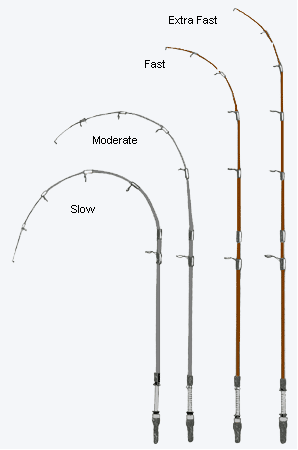
Fishing rod action refers to the ability of the fishing rod to bend and revert back to its natural shape.

Taper often used synonymously with action, taper describes not only the thickness of the rod but also the thickness of the wall of the blank and where along the blank less material is used allowing more bend. Graphite classified by the tensile modulus (modulus of elasticity) of the carbon fibers, the measure of stiffness, how far the material stretches for a given stress. The higher the modulus of the carbon fiber used, the lighter blank can be produced for any given stiffness. Graphite by itself is very strong and increasing high modulus of blanks makes the rods lighter, more sensitive and more efficient due to the ability to make blanks with thinner walls. For most cases taper is the same as action.
The action refers to how much a rod bends under pressure on the tip either you're casting or have a fish at the end of the line.
- An extra fast action rod bends just at the tip.
- A fast action bends in the upper 1/3 to 1/4 of the rod.
- A moderate-fast action rod bends over the lover 1/3.
- A medium/moderate action rod bends over the last half.
- A slow action rod bends all the way into the handle.
Back to top
What's one of the first things people do when evaluating a fishing rod? They typically check the action.
How to Check the Action of a Fishing Rod?
A simple way to check the action of the rod is to flex it against the ground or agains the ceiling. If it is not a pole, make sure the guides are facing upwards, then touch the end of your fishing rod on the ground (or ceiling) and apply some pressure. NOT TOO MUCH PREASURE. You will quickly be able to check the action of that fishing rod, without running the risk of breaking it.
A fishing rod with a fast tip means that the tip of the rod is flexible and the rest of the rod is stiff. Somewere from 1/4 to 1/3rd of your rod should be more flexible than the rest. The action of a rod is a rating, which describes the amount of curvature that occurs in the blank due to loading with weight. A rod's action determines its flexibility; it determines, in part, how much control you have over the fish. The faster the action, the more pressure you can put on the fish, the further towards the tip the rod bends. The slower the action, the further towards the middle of the rod and so on...
Softer action rods are more forgiving and have fewer tendencies to throw live bait from your hook.
Fast-action and slow-action rods have their own unique characteristics. A fast-action rod is more sensitive compared to a slow-action Fishing Rod. For example with a fast-action rod you will be able to know if the lure reached the bottom by filling the lure's vibrations. On the other hand, a soft cast is possible using a slow-action rod, unlike a fast-action rod wherein it may break the bait off. If you are using a very light Fishing Line, it is advisable to use a slow-action rod when casting a considerable amount of bait or lure. Fast action rods put more force into your throw and give you longer casts.
Casting distance is one of the important considerations of rod action. The slower the action the better the rod will cast. Rods that have a slower action have a wider curve on their parabolic bend, and have stored more energy when casting. This is called "rod loading". In effect, the more the rod loads the more of the rod you use to cast. Fast action rods bend closer to the tip, using less of the rod to cast, they are great for most applications where a short to long casting distance is involved and single hooks are the rule, such as worm and jig fishing. Medium and medium-fast rods will usually provide a little more casting distance and still provide adequate hook setting power. These actions are often used for applications that involve treble hooks, such as crank baits and top water lures or other reaction baits such as spinner baits. Most bass rod actions are fast to very fast because this action generally provides better sensitivity and faster power for hook setting. By faster power we mean the rod 'shuts off' faster, or the bend ends higher on the blank, which means you don't have to move the rod as far on the hook set to get into the stiffer part of the blank.
You can think of action as how 'fast' it takes for the blank to return to 'rest' after being put under load. A fast blank is not going to flex very far from its resting state. Once the load is released it will not take long for the blank to return. Conversely, a 'slow' blank is going to flex in the top three-fourths of the blank. The range of motion is going to be much greater and will take longer for the blank to return to the at-rest state, thus, the term 'slow' is used to describe this characteristic.
Extra fast, fast, moderate and slow actions refer to flex and ultimately the relative time it takes for the rod to return to the at-rest position once released from under a load. By knowing and understanding the action of a blank, you can utilize that blank's properties to enhance a particular technique.
With equal weight a fast action rod will start to bend more toward the tip where as a slow action rod would tend to bend over the entire length of the shaft. A medium action rod would start to bend in the middle. The action is controlled by the taper of the rod itself. A fast or short taper would make a slower action rod and a slow or long taper would make for a faster action rod.
Back to top
Extra-Fast Action fishing rod
The main benefits of an Extra-Fast blank are its sensitivity and the quick response to bringing the natural power of the blank into play when fighting the fish. The Extra-Fast blanks are stiffer than slow/soft blanks, it will send out vibration to your hand much more powerfully. With the Extra-Fast blank best to use a single hook applications where sensitivity is needed to detect the smallest baits, then instant power to set the hook. Worm and jig presentations are main techniques for Extra-Fast blanks.
The Extra-Fast blank provides outstanding sensitivity and efficient access to the power of the blank; the Extra-Fast tip works against you rather while fighting the fish. Because the Extra-Fast blank returns to the at-rest position very quickly, the Extra-Fast tip makes it very hard to keep right pressure to keep the lure secure. The hooked fish are fighting to get loose; creating too much pressure with a stiff blank could cause the fish to throw the bait. Too little tension will also help the fish throwing the lure.
Extra Fast action rods are better suited for hook sets when fishing vertical then horizontal. Using this action rods are best for pole fishing with worm, jigging, or live bait fishing. Great using for Yellow Perch, or Green Sunfish, Bluegill, Crappie, or Smallmouth Bass.
Back to top
Fast Action fishing rod
Fast Action: fishing rod will bend very little, in only the top third or less of the blank. A rod of this type is ideal for large game fishing, or when fishing extremely heavy cover or weeds, and you have to get the fish's head up and away fast. A fast action rod will allow you to set the hook hard and powerfully. Musky, Pike and Largemouth Bass are suited to this style of rod. Fast action rods are great for most species where a short to long casting distance is involved and single hooks are the rule, such as worm and jig fishing.
The Fast action blank has more sensitivity, more flex than Extra-Fast blank. The more flexible tip will provide better fish fighting capability. The blank can uphold better pressure on the line. With the Fast action blank better to use a single hook application where sensitivity as important as fighting ability, where the throwing single hook rigs through and over loose weeds and grass.
Fast action rods do extremely well at setting hooks on fish that are engaged in pursuing moving baits. Texas rigged, Carolina rigged worms and jig presentations are main techniques and presentations for Extra-Fast blanks. A more limber, flexible rod would have difficulty generating the needed power to jerk the lure free from weeds and grass. If you are working a jig or live bait rig, than you most likely will want to use a good quality graphite rod, with a fast tip. The tip will help you detect the bite, while the remainder of the rod (which is relatively stiff) will give you the backbone and power that you need, which will also allow you to set the hook quickly. Fast-tipped fishing rods would also be the preferred choice for ice fishing.
Back to top
Moderate to Slow action fishing rod
Medium Action: A medium or moderate action rods will bend in the top half of their length, allowing an angler to fish both for small and large species with good control and hook setting allowances. These rods will allow a fisherman to fish in a wide range of situation and for a varied list of species. These rods will usually offer a little more casting distance and provide plenty hook setting power.
Slow Action: A slow action rod will bend throughout the whole length of the rod, providing the most flexible action available. These rods are used exclusively for small fish, like a panfish, allowing a better fight for the angler, and a shock absorber so that the hook is not ripped clear through the mouth on hook sets.
These actions are often used for species that involve treble hooks. The 'bite' of a treble hook is not as deep as a big single worm hook and it is easier to tear the hook out of a strong fish, plus the slower action will not pull the lure out of the fish's mouth before it fully engulfs it. The type of lure you use will usually determine the action of the rod you should use.
Most bass rod actions are fast to very fast because this action provides better sensitivity and faster power for hook setting. By faster power we mean the rod 'shuts off' faster, or the bend ends higher on the blank, which means you don't have to move the rod as far on the hook set to get into the stiffer part of the blank.
A rod with a slow tip is basically the opposite of a fast tip. A slow tip rod is very flexible, from the tip almost right down to the base. Just take the length of your rod and divide by 4. In the case of a 6 foot rod, from the tip down about 4 1/2 feet, will be more flexible, while the base of the rod - the remaining 1 1/2 feet - will be stiff. A slow tip fishing rod would be better suited for casting lures. The slow tip will allow you more time to set the hook and basically the whole rod will bend and flex, which would better absorb any sudden movements while fighting fish. Moderate-fast action rods will provide more casting distance and still provide sufficient hook setting power.
The Moderate to Slow action blanks are usually good for multi-hook lures such as crank baits and top water lures or other reaction baits such as spinner baits, rattle baits and jerk baits. These fast moving fish finding baits work best with a soft tip action and the ability to throw the lure over long distances. These lures and presentations typically require less sensitivity and focus more on keeping the fish hooked. The wire diameter of the treble hook is typically thinner than a single hook and requires less pressure to set the hook. There are more hooks with multi-hook lures means there are more possibilities for a good catch.
The slow tip causes the blank to return to the at-rest position much more slowly than faster action blanks. The proper tension is much easier to maintain, keeping the hook hooked while the fish fighting. The rod is much more adept at reacting to the fish's abrupt actions.
For Bluegill, Crappie and small Trout, a light power, fast action spinning rod is a good choice. A quality ultra-light rod also works for these fish, but many ultra-lights are too short and too wimpy. A 4 1/2-foot ultra-light rod with the backbone of a boiled noodle isn't worth the packaging it came in for any species.
For larger Black Bass,
Walleye and Channel Catfish, a medium power, moderate fast or fast action baitcasting rod works well. Baitcasting reels have an enclosed spool and mount on top of the rod. They are the best choice for lines of 10 pound test or higher. They require much greater practice than spinning gear to use effectively.
Choose the moderate fast action if you plan to fish leeches or minnows for
Walleye, or chicken livers for
Channel cats. The slightly softer action usually helps prevent you from throwing off the bait while casting. If you plan to jig and worm fish for Largemouth Bass and occasionally fish for the other species, choose a fast action, medium power rod.
Get a medium heavy or heavy power baitcasting rod with a fast action for Striped Bass, Muskellunge,
Flathead Catfish and
Blue Catfish. This set-up is also good for flipping or pitching jigs for Largemouth Bass. Choose a moderate or slow action rod with a medium-heavy or heavy power rating if you plan to use live bait. Again, the softer action protects against throwing the bait off the hook on the cast. These rods possess enough strength to land these fish, but they can also handle the heavy lures and strong line needed.
Back to top


































